A deviation in which the nose, area above the lip, forehead, and cheeks sweat profusely is known in medicine as facial hyperhidrosis. Increased sweating in this area occurs during exercise and stress, and this is the norm. But sometimes excessive sweating in an adult is caused by disorders in the body that require timely identification and treatment.
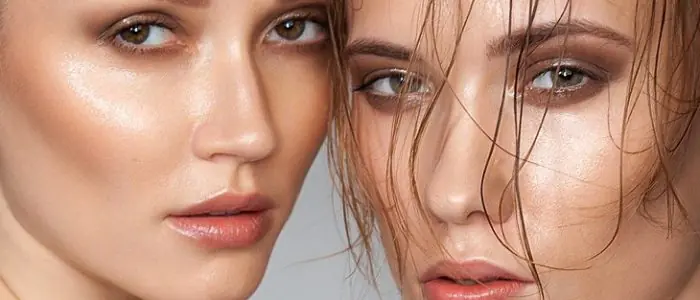
What are the causes of hyperhidrosis?
It is customary to divide hyperhidrosis of the head and face into 2 types, taking into account the causes of occurrence:
Primary sweating of the forehead and face is caused by genetic abnormalities, heredity or pathologies in the functioning of the central nervous system.
In this case, facial hyperhidrosis is more difficult to cure. If severe sweating of the head and face is caused by abnormalities in the functioning of the central nervous system, then it is possible to get rid of the disease. But it is impossible to eliminate perspiration that has arisen against the background of genetic factors and heredity. In this case, doctors recommend taking preventive measures for hyperhidrosis.
Secondary causes of facial sweating are more extensive and easier to treat. These include:
- pathologies in the body of various etiologies;
- drug therapy;
- hormonal disorders that are often observed in women during pregnancy, menopause or menopause;
- thyroid disorders;
- excessive alcohol intake;
- overweight;
- cardiovascular diseases;
- excess of food additives in the diet;
- neurotic pathologies;
- allergic reaction.
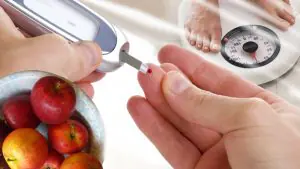
Increased sweating can occur due to diabetes.
The patient’s face and head often sweat due to the following pathological conditions:
- increased thyroid function;
- diabetes;
- hormonal formation of the adrenal glands;
- carcinoid syndrome;
- impaired functioning of the pituitary gland;
- tuberculosis disease;
- penetration of harmful microbes into the body;
- malarial infection;
- HIV and AIDS;
- cancerous tumors;
- brain damage;
- Parkinson's disease;
- neurosyphilis;
- stroke and vegetative-vascular dystonia.
Return to contents
What are the signs to recognize sweating?
If a person notices that the face begins to sweat a lot in the morning or at night, one should consult a doctor, since such a condition may signal a pathological disorder. If the sweating of the neck, nose and other parts of the face is moderate and no additional symptoms appear, then there is no need to worry too much. But you should be concerned if the perspiration on the nose and other parts of the face increases daily and is accompanied by pathological manifestations. The table shows the degrees of sweating of the head and face and the characteristics of their course.
Redness of the face is often accompanied by hyperhidrosis.When a patient sweats heavily in the head and face due to internal deviation, additional symptoms will appear:
- the occurrence of night sweats, signaling the development of tuberculosis;
- unpleasant odor of secreted sweat;
- fever, large lymph nodes, cough - a signal of the spread of an infectious focus;
- redness all over the face;
- itching and burning sensation in the sore area;
- blue discoloration of the facial skin.
According to statistics, more than half of the population suffers from varying degrees of facial hyperhidrosis, but do not go to doctors, believing that the disorder cannot be treated and is a genetic feature.
What methods are used to detect sweating?
The sweaty face of a man and a woman is treated by a doctor after carrying out diagnostic procedures. It is strictly not recommended to treat hyperhidrosis on your own without identifying the source of sweating, since such actions can aggravate the problem. A therapist, endocrinologist, dermatologist or neurologist will help solve the problem of sweating. The diagnostic complex for hyperhidrosis includes the following procedures:
- inspection of the affected area;
- taking anamnesis;
- carrying out evapometry to assess the rate of transepidermal water loss;
- Minor's test involves an iodine-starch test;
- general blood test, urine;
- blood donation for biochemistry, hormones, sugar;
- rarely - a histochemical test (color reaction to a-amino acids).
Return to contents
Treatment: what to do if your face is sweating?
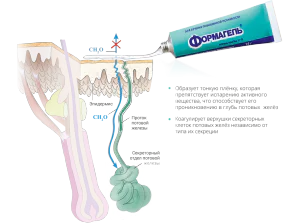
Sweating of the face and head causes a lot of inconvenience to the patient, so therapeutic measures are required to eliminate the problem. To treat hyperhidrosis, special face creams, solutions, and medications are used. It is also possible to use folk remedies that will help you quickly cope with mild facial sweating.
Help with medicines
Medications that are used strictly as prescribed by a doctor help reduce sweating. If one medicine for hyperhidrosis does not work, then another is prescribed. If there is no effect of drug treatment or in the later stages of hyperhidrosis, surgery is prescribed. It is possible to carry out therapy through Botox injections, but such procedures are not affordable for everyone. Doctors often prescribe the following medications to patients for excessive sweating:
- cream “Formidon” or “Formagel”;
- anticholinergic drugs;
- medications that reduce hyperhidrosis - Oxybutin, Benzotropin;
- medicines including belladonna - “Bellataminal”, “Belloid”, “Bellaspon”;
- drugs with a sedative effect - “Persen”.
Laser therapy is no less effective for hyperhidrosis, as there are no adverse reactions and the problem of sweating is painlessly eliminated. Doctors recommend that the patient undergo several hypnosis sessions, take yoga classes, and meditate. Physiotherapy procedures provide special results:
- electro- and iontophoresis;
- electrosleep;
- climate therapy;
- water procedures;
- electrotherapy.
A special deodorant is used that eliminates facial hyperhidrosis. Deodorants help only at the initial stages, when increased sweating occurs, then such products will not help.
How effective are folk remedies?
Treatment with folk remedies for hyperhidrosis is used only after consultation with a doctor. One alternative therapy is powerless for severe sweating, so it is recommended to use it in conjunction with medications. Natural ingredients almost never cause side effects, are easy to use and accessible to every patient with hyperhidrosis. Facial hyperhidrosis is effectively treated with the following recipes:
- Herbal infusions for herbal baths. You can make an infusion from oak bark, chamomile inflorescences, string and thyme.
- Poison from medicinal herbs. For external use, prepare a decoction of mint, sage and oak bark. Take 1 tbsp of each component. l. and pour 500 ml of boiling water. After straining, add 100 g of vodka and wipe the problem areas twice a day.
- Birch leaf mask. To prepare, you need a small handful of leaves, which is poured with 250 ml of boiling water. After thoroughly squeezing, the leaves are applied to the affected area.
- Chicken protein mask. Add 20 g of starch and a couple of drops of lemon juice to thoroughly beaten raw protein. The finished mixture is applied to the skin for a quarter of an hour.
- Rubbing using cucumber. The vegetable is cut into thin slices and the affected area is wiped three times a day.
Return to contents
What are the dangers of hyperhidrosis?
If a person sweats heavily on the forehead and face, and no measures are taken, then the following complications of hyperhidrosis are possible:
- psychological discomfort with the development of a depressive state;
- neurosis;
- fungal infection of the skin;
- significant irritation on the epidermis;
- the appearance of lichen.
Return to contents
What is prevention?
Regular hygiene procedures and the use of a special face cream will help you avoid sweating. They pay special attention to hygiene in the summer. You should eat right, avoid stress and spend more time outdoors. An important preventive measure for hyperhidrosis is avoiding alcohol and smoking.
» Special offer! Eliminate sweating.
Both axillary areas: Relatox 100 units - 15,000 rub.
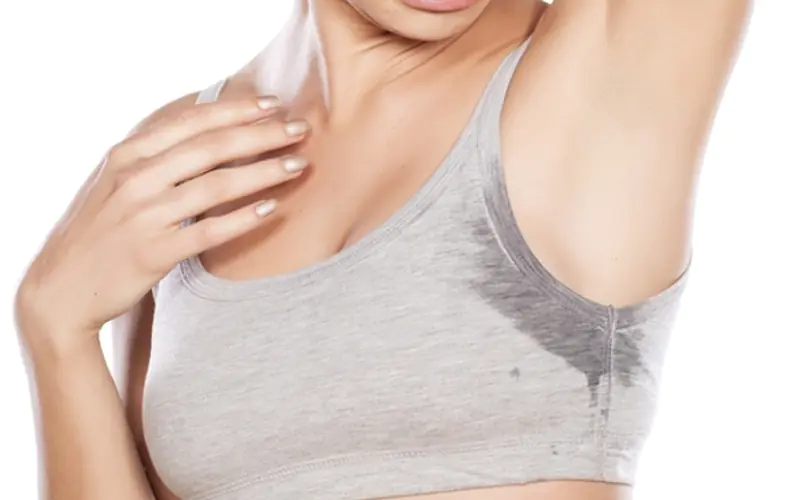
Hyperhidrosis refers to a pathology of the sweat glands, which is accompanied by increased sweat production. Depending on the causes of occurrence, there are two main forms of the disease:
- General hyperhidrosis is a consequence of improper functioning of the nervous system. In this regard, it is usually observed in stressful situations and instability of the patient’s emotional background. Sweating in this case can be provoked by excessive physical exertion or a sharp increase in ambient temperature, when signs of illness act as a response of the body to an external stimulus.
- Localized hyperhidrosis often occurs against the background of disorders associated with the functioning of the cardiovascular system (for example, with vegetative-vascular dystonia). In this case, sweat can appear on the palms of the hands and soles of the feet, in the groin folds and armpits. The anus area often sweats. Beads of sweat may appear on your upper lip or chin.
Pathological excessive sweating can be explained by the presence of an infectious disease (for example, tuberculosis) or malignant neoplasms (tumors) of various organs.
With hyperhidrosis, the patient's hands and feet are constantly wet and cold. Due to this feature, with a long course of pathology, changes in the skin in these places are observed. Patients often complain of a fetid odor of sweat (bromidosis), so secretion of secretions in excess amounts can lead to not only physiological, but also psychological problems (low self-esteem, depression, etc.) that arise as a result of difficult contact with people. In some cases, colored sweat may appear, colored blue, red or yellow.
When a diagnosis of hyperhidrosis is made, patients should limit their fluid intake. Local treatment involves treating areas of increased sweating with special solutions (including potassium permanganate). Decoctions of oak bark and all kinds of powders will help reduce the manifestation of pathology. However, none of the above methods can completely get rid of hyperhidrosis. Cosmetology helps solve this problem. In this regard, in our clinic, in the fight against hyperactivity of the sweat glands, injections of Botox and its French analogue Dysport are performed, which differ from each other in dosage (for Dysport it is higher).
Botox is a drug made from botulinum toxin type A and is used to eliminate facial wrinkles. The principle of action of this substance is based on the destruction of one or more elements of the SNARE protein complex. The main task of these proteins is to control nerve impulses that are transmitted from muscles to tissues. As a result of exposure to botulinum toxin, which is injected subcutaneously in small doses (usually 100 units) into the desired area, an obstacle appears in the path of transmission of these impulses, due to which muscle activity is temporarily blocked. This property is taken as a basis and within the framework cosmetic treatment method hyperhidrosis, when postganglionic sympathetic nerves lose their ability to influence the process of sweating. The pronounced effect lasts for 6-8 months.
Considering the fact that quite often hyperhidrosis indicates disorders of the nervous system, it is recommended to consult a neurologist.
As preventive measures, you can consider restrictions associated, first of all, with wearing clothes and shoes. At the same time, it is worth limiting, or better yet completely abandoning, rubber shoes, nylon stockings and synthetic materials. A special place is also occupied by maintaining hygiene in areas with increased sweating. All patients are recommended to engage in any kind of sports.
Hyperhidrosis is an extremely unpleasant disease, but it can be cured. Find out how.
p, blockquote 1,0,0,0,0 —>
What it is?
Hyperhidrosis is an overactivity of the sweat glands, which leads to increased sweat production.
p, blockquote 2,0,0,0,0 —>
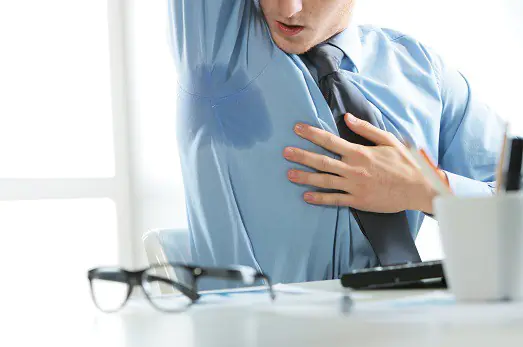
p, blockquote 3,0,0,0,0 —>
Hyperhidrosis can be localized, in which excessive sweating is observed only in certain areas of the body, or generalized, in which sweat is released literally throughout the body. The primary and secondary forms will also be distinguished. The first develops regardless of any diseases or conditions, while the second, as a rule, is a consequence of certain health problems.
p, blockquote 4,0,1,0,0 —>
What causes hyperhidrosis?
In general, a person needs sweat, as it allows for thermoregulation. For example, a person sweats in the heat, during increased physical activity, and so on. Evaporating moisture cools the body and allows it to maintain normal temperature.
p, blockquote 5,0,0,0,0 —>
The sympathetic nervous system is responsible for the work of the sweat glands, which sends signals at the right moments and activates the glands. But if the operation of this system is disrupted for some reason, then sweat can be released at any time, regardless of the ambient temperature and the person’s condition.
p, blockquote 6,0,0,0,0 —>
What are the causes of hyperhidrosis? They can be very different:
p, blockquote 7,0,0,0,0 —>
- diseases of the thyroid gland, in particular hyperthyroidism;
- poor diet (eating excessively spicy or hot foods can lead to increased sweating);
- some malignant neoplasms, for example, Hodgkin's lymphoma;
- infectious diseases such as tuberculosis, malaria, syphilis, brucellosis and some others;
- wearing very tight clothing made of dense, synthetic and breathable fabrics;
- diabetes;
- overweight or obesity;
- menopause in women;
- parkinsonism;
- some diseases of the cardiovascular system, such as tachycardia;
- cystic fibrosis;
- frequent stress, increased nervous tension, overexcitement;
- taking certain medications;
- consequences of a stroke (such a disease can lead to damage to the hypothalamus, as well as to disruptions in the functioning of the thermoregulation center located in the brain).
Hyperhidrosis can also develop independently, in which case heredity is the influencing factor in most cases.
p, blockquote 8,0,0,0,0 —>
Manifestations
The symptoms of hyperhidrosis cannot be ignored, because with this disease there is a significant and causeless increase in sweating. Sweat is released no matter what a person does or what the air temperature is. Sweating can occur even in a calm state, including in the cold. The skin becomes very damp and also cold. This causes severe discomfort.
p, blockquote 9,1,0,0,0 —>

p, blockquote 10,0,0,0,0 —>
As for the area of distribution of manifestations, hyperhidrosis of the feet and armpits is most common, since it is in these areas that the largest number of sweat glands are located. But other parts of the body can also sweat, for example, the perineum, palms, inguinal folds, chin, area above the upper lip, and so on.
p, blockquote 11,0,0,0,0 —>
Who to contact?
Which doctor treats hyperhidrosis? Everything will depend on the reasons that provoked such a disease. For primary hyperhidrosis that develops independently and is not accompanied by other symptoms, you should consult a dermatologist. If there are other alarming signs, then it is better to go to a therapist. He will order an examination, find out the cause of increased sweating and refer you to the right specialist.
p, blockquote 12,0,0,0,0 —>
Diagnostics
Diagnostics may include the following activities:
p, blockquote 13,0,0,1,0 —>
- Evapometry. A special device is used that allows you to set the rate of sweat evaporation from the surface of the body.
- Gravimetry is a study in which a piece of filter paper with a certain mass is applied to dry skin. It remains on the body for some time, after which its weight is measured to determine the amount of sweat released.
- General urine and blood tests.
- Electrocardiogram.
- Ultrasound examination of the thyroid gland.
- Blood tests for infections.
- Tests to determine the level of thyroid hormones.
How to treat?

p, blockquote 14,0,0,0,0 —>
Treatment of hyperhidrosis should be comprehensive and aimed, first of all, at eliminating the causes of the disease.
p, blockquote 15,0,0,0,0 —>
Therapy may include the following areas:
p, blockquote 16,0,0,0,0 —>
- Compliance with personal hygiene rules is mandatory. You should shower regularly and change clothes and underwear. You also need to use a deodorant, and if sweating is strong and the sweat has an unpleasant odor, then the doctor may recommend an antiperspirant that will reduce the excretory flows of the sweat glands.
- Iontophoresis. This procedure involves exposing the body to a constant galvanic current. Some medications or medicinal formulations may also be used additionally.
- Botox (botulinum toxin) injections. Armpit hyperhidrosis is treated in this way. The fact is that Botox can block nerve impulses going to the sweat glands. And if they do not receive signals, then sweating will noticeably decrease.
- Radiotherapy is also used. This method involves exposing the body to radio waves.
- Proper nutrition is also important. Any foods that may speed up blood circulation should be excluded from the diet. These include alcoholic drinks, spicy dishes, hot food, coffee, and some spices.
- What to do if the methods listed above are ineffective? The only solution will be surgical treatment. It can be carried out in several ways. The first is sympathectomy. Such an intervention involves the removal of sympathetic nerve ganglia that send impulses to the glands. The second method is to remove the sweat glands. In the armpit area, curettage is often performed, in which the fatty tissue along with the glands is scraped out. The third method is the most radical, as it involves removing areas of the skin with the largest accumulations of sweat glands. The effect is one hundred percent, but after the operation there will be unattractive scars.
- You can try to treat hyperhidrosis at home with folk remedies. So, some advise rubbing boric acid powder into your feet and armpits. A decoction of oak bark is effective. In addition, you can use dry oak bark by pouring it into socks and wearing them at night. You can also prepare a sage decoction. Try wiping sweaty areas with a not too concentrated vinegar solution. Among other things, you can make baths or compresses with a weak solution of potassium permanganate.
All that remains is to wish to get rid of such a delicate problem as soon as possible.
p, blockquote 17,0,0,0,0 —> p, blockquote 18,0,0,0,1 —>
>



